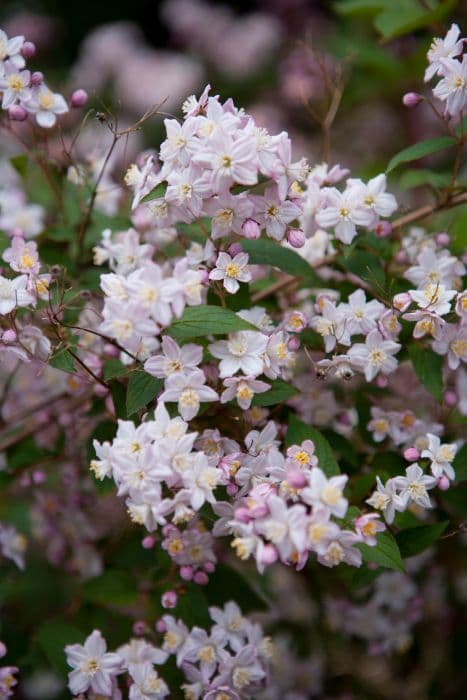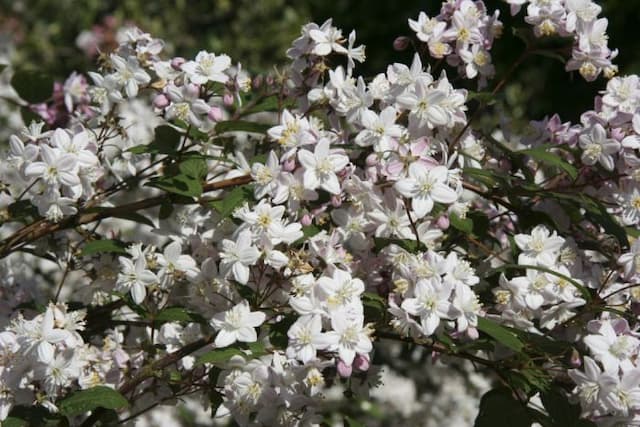Hydrangea Hydrangea macrophylla Hot Red = 'Agrihydradrie' (PBR) (H)
![hydrangea [Hot Red]](/_next/image?url=https%3A%2F%2Fplants-admin.emdemapps.com%2Fimages%2Fplants%2F%2Fimages%2F604b5b04ea2db.png&w=3840&q=75)
ABOUT
The Hydrangea macrophylla Hot Red, commonly known as the Hydrangea, typically showcases a striking display of vibrant, richly colored blooms. The flowers of this variety are notable for their intense red hue, which can range from deep pink-red to true ruby, depending on the acidity of the soil in which the plant is grown. They emerge with a lush character, giving a full, rounded appearance owing to the numerous individual petals on each flowerhead. The blossoms generally form large, rounded clusters, commonly referred to as mopheads, which create a bold visual impact within any garden or landscape. The petals of Hot Red Hydrangea have a sturdy texture and may display slight variations in color intensity throughout, contributing to the overall dynamic look of the inflorescence. The plant is graced with broad, sizeable leaves that sport a deep green color, providing a lush backdrop that makes the red hues of the flowers truly pop. This shrub's leaves can have serrated edges and a somewhat glossy finish, which can catch the sunlight and add a shimmering quality to the plant's overall appearance. The contrast between the dark green foliage and the red mophead blooms makes this Hydrangea a particularly eye-catching specimen in the landscape. The foliage and the flower clusters work together to create an ornamental quality that is both opulent and robust, attracting various pollinators and providing a stunning visual portrayal throughout its blooming season.
About this plant
 Names
NamesFamily
Hydrangeaceae.
Synonyms
Hot Red Hydrangea, Red Hydrangea.
Common names
Hydrangea macrophylla 'Hot Red', Hydrangea macrophylla 'Agrihydradrie'.
 Toxicity
ToxicityTo humans
The common hydrangea, of which Hydrangea macrophylla Hot Red is a variety, can be toxic if ingested. The plant contains compounds such as hydrangenol, which are found in the leaves and flower buds. When ingested in large quantities, these compounds can cause symptoms like nausea, vomiting, and diarrhea. In some cases, more severe symptoms can occur, including dizziness, difficulty breathing, and lethargy. The severity of poisoning symptoms can vary depending on the amount consumed and the sensitivity of the individual.
To pets
Hydrangeas, including the Hydrangea macrophylla Hot Red variety, are toxic to pets. They contain cyanogenic glycosides, which can release cyanide when chewed or broken down during digestion. Symptoms of hydrangea poisoning in pets can include vomiting, diarrhea, lethargy, abdominal pain, and depression. In more severe cases, symptoms may progress to increased heart rate, heavy breathing, and weakness. If a pet consumes hydrangea, it is essential to consult a veterinarian as soon as possible to manage the toxicity and prevent more serious complications.
 Characteristics
CharacteristicsLife cycle
Perennials
Foliage type
Deciduous
Color of leaves
Green
Flower color
Red
Height
4 feet (1.2 meters)
Spread
5 feet (1.5 meters)
Plant type
Shrub
Hardiness zones
6
Native area
Japan
Benefits
 General Benefits
General Benefits- Aesthetic Appeal: The Hydrangea macrophylla Hot Red sports vibrant red blooms that can add a pop of color to any garden or landscape setting.
- Seasonal Interest: It blooms from early summer into fall, offering a long season of visual interest in the garden.
- Attracts Pollinators: Hydrangeas can attract bees and butterflies, which are beneficial for pollinating other plants in the garden.
- Versatility in Landscaping: It can be used for borders, as a focal point in garden beds, or for planting in containers.
- Easy to Grow: Generally, Hydrangeas are hardy and can thrive with minimal care once established, making them suitable for many gardeners.
- Pruning Tolerance: The plant can be pruned to maintain a desired size and shape, and it often responds well to cutting back.
- Shade Tolerance: It has the ability to grow in partial shade, offering a flowering option for less sunny spots in the garden.
 Medical Properties
Medical PropertiesThis plant is not used for medical purposes.
 Air-purifying Qualities
Air-purifying QualitiesThis plant is not specifically known for air purifying qualities.
 Other Uses
Other Uses- Addition to Aquatic Landscapes: Though not a true aquatic plant, cut stems of hydrangea can be floated in water features for temporary aesthetic enhancement.
- Craft Material: Dried hydrangea blossoms can be used in the creation of wreaths, arrangements, and other craft projects due to their sturdy structure and vibrant colors.
- Color-Changing Experiments: Gardeners might use hydrangeas to experiment with altering soil pH levels to change the flowers' color, making them a useful educational tool for demonstrating soil chemistry.
- Fabric Dye: Historically, parts of hydrangeas have been used to create natural dyes for fabrics, yielding hues from pale green to blue, depending on the part of the plant used.
- Potpourri Ingredient: Dried hydrangea petals can be added to potpourris to give texture and color variation.
- Photography Subject: With their striking color, hydrangeas are often used as subjects in macro photography to capture the intricate details of their flowers.
- Wedding Decor: Hydrangeas are popular for use in wedding ceremonies and receptions as part of the decor, due to their full blooms and the ability to fit into a variety of color themes.
- Book Pressing: The robust yet flat flowers of hydrangeas make them ideal for pressing in books for craft purposes or as herbarium specimens.
- Conservatory Collections: Hydrangeas can be grown inside conservatories where their bright colors can be enjoyed year-round in controlled climates.
- Botanical Illustration: Artists often use hydrangeas as subjects for botanical illustration, capturing their complex inflorescences and diverse range of colors.
Interesting Facts
 Feng Shui
Feng ShuiThe Hydrangea is not used in Feng Shui practice.
 Zodiac Sign Compitability
Zodiac Sign CompitabilityThe Hydrangea is not used in astrology practice.
 Plant Symbolism
Plant Symbolism- Heartfelt Emotions: Hydrangeas are often seen as a symbol of deep and heartfelt emotions, and the Hot Red Hydrangea, with its vivid color, can represent passion and intensity in these feelings.
- Gratitude: The generous, round blooms of the Hydrangea can signify gratitude and thankfulness, making it a popular gift to express appreciation.
- Understanding: Hydrangeas can be used to express understanding between people, often used in situations where forgiveness is sought or offered.
- Abundance and Prosperity: With its lush, full blooms, the Hydrangea, especially the Hot Red variety, can represent abundance and prosperity.
- Vanity or Frivolity: In some cultures, Hydrangeas have a less positive connotation, symbolizing vanity or boastfulness due to their showy appearance.
 Water
WaterBigleaf Hydrangeas require consistent moisture, so water them deeply once a week, ensuring that you provide enough water to soak the root zone. During hot or dry weather, this may need to be increased to twice per week. Avoid overhead watering to minimize leaf wetness and potential fungal diseases. It's best to check the top inch of soil; if it feels dry, it's time to water again. Bigleaf Hydrangeas typically need about 1 gallon of water per plant each time you water.
 Light
LightFor Bigleaf Hydrangeas, the ideal lighting condition is partial shade with some morning sun and protection from the harsh afternoon sun. They thrive in a spot that receives dappled sunlight throughout the day or filtered light, such as that found under high-canopy trees. Avoid deep shade as this can diminish bloom production.
 Temperature
TemperatureBigleaf Hydrangeas grow best in temperatures between 65°F and 75°F but can tolerate a range from about 50°F at night to 80°F during the day. They can withstand a brief period of colder temperatures down to freezing, but prolonged exposure to temperatures below 32°F or above 86°F can damage the plant. Planting in an area with some protection from extreme temperatures can help manage these conditions effectively.
 Pruning
PruningPrune Bigleaf Hydrangeas only if necessary, typically to remove dead or broken branches or to manage the shape, immediately after blooming since they bloom on old wood. Avoid extensive pruning late in the season as you may inadvertently cut off next year's buds. Annual light pruning to encourage new growth and potential reblooming can occur just as the flowers fade.
 Cleaning
CleaningAs needed
 Soil
SoilThe best soil mix for Hydrangea, commonly known as Bigleaf Hydrangea, is well-draining, rich in organic matter with a pH of 5.5 to 6.5 to keep the red blooms bright. Incorporate compost or peat moss into the soil to improve fertility and structure.
 Repotting
RepottingBigleaf Hydrangeas should be repotted every 2 to 3 years or when they become root-bound, to ensure sufficient space for growth and nutrient absorption.
 Humidity & Misting
Humidity & MistingBigleaf Hydrangeas thrive in environments with moderate to high humidity levels, ideally between 50% to 70% which supports their lush foliage and bloom production.
 Suitable locations
Suitable locationsIndoor
Provide bright light and moist soil.
Outdoor
Plant in morning sun, afternoon shade.
Hardiness zone
6-9 USDA
 Life cycle
Life cycleHydrangea macrophylla Hot Red, commonly known as Hortensia, begins its life as a seed, requiring a period of stratification or cold treatment before germination occurs. Once sprouted, the young seedlings grow into juvenile plants, developing their root systems and first true leaves. As they mature, they enter the vegetative growth stage, forming lush foliage and robust stems over several years. Upon reaching maturity, Hortensias produce large, showy flower heads that can range in color from pink to red, depending on the soil pH. These flowers bloom in early to mid-summer and can last into the fall. After the blooming period, if pollination occurs, the plant may produce seeds, completing its life cycle, while the perennial parts of the plant go dormant in winter and prepare for the next growing season.
 Propogation
PropogationPropogation time
Spring-Early Summer
The Hydrangea macrophylla Hot Red, commonly known as Hot Red hydrangea, is most commonly propagated via softwood cuttings. This method is done during the late spring or early summer when new growth is still tender and green. A 4 to 6 inch cutting is taken from a healthy, disease-free mother plant, just below a leaf node, where the concentration of hormones that encourage root growth is high. The lower leaves are removed, and the cut end is dipped in rooting hormone to facilitate root development. The prepared cutting is then placed in a pot filled with a mix of peat and perlite or sand to ensure good drainage. The pot is kept in a warm, 65 to 75 degrees Fahrenheit (approximately 18 to 24 degrees Celsius), lightly shaded location and maintained moist until roots have established, which typically takes several weeks. Once rooted, the new hydrangea plants are transplanted to their permanent locations.








![Hydrangea [Early Sensation]](/_next/image?url=https%3A%2F%2Fplants-admin.emdemapps.com%2Fimages%2Fplants%2F%2Fimages%2F604b6150338db.png&w=640&q=75)
